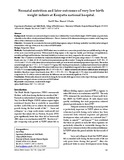Neonatal nutrition and later outcomes of very low birth weight infants at Kenyatta National Hospital
Abstract
Background: Extensive research in developed countries has established that very low birth weight (VLBW) infants are particularly vulnerable to the effects of early nutritional deficiencies. There is, however, little information from poor countries on the long-term effects of these deficiencies in such infants.
Objective: Determine the association between neonatal feeding regimens and post-discharge morbidity/ mortality and neurological abnormalities at the age of two years for a cohort of VLBW infants.
Design: Prospective Cohort.
Methods: One hundred and seventy five VLBW infants were recruited over a consecutive period of one year and followed up to the age of two years corrected for gestation. With neonatal feeding regimes as the exposure variable, post-discharge re-hospitalization, mortality and Saigal and Rosenbaum's functional disability assessment scores were compared as the outcome variables.
Results: The 175 infants recruited into the study had median birth weight of 1400 +/- 103 grams and gestation 32 +/- 2.3 weeks. The male:female ratio was 2:3 while 64 (36.6%) had been born intrauterine growth retarded. During the newborn period, 83(47.4%), 35 (20.0%) and 57 (32.6%) of the infants fed on exclusive breast milk, pre-term formula and mixed preparations respectively. The median neonatal weight gain was 17 +/- 2.5, 15 +/- 2.0 and 13 +/- 3.9 grams/kilo/day for preterm formula, combined and exclusive breast milk fed infants respectively. More of the infants fed on breast milk alone were re-hospitalized compared to those on pre-term formula, RR 2.3; 95%CI 1.4-3.6 or mixed milk preparations, RR 1.9; 95% CI 1.4-2.7. Infants exclusively fed on breast milk had more neurological disabilities than those on pre-term formula alone, RR 3.2; 95% CI 1.2-8.1. Though only 22.9% of pre-term milk fed infants died compared to 36.1% of those on breast milk alone the difference was not statistically significant, P>0.05.
Conclusion: Nutritionally enhanced enteral feeds during the first month of life appear to have reduced post-discharge morbidity and improved neurological outcomes at two years in VLBW infants
URI
http://www.ncbi.nlm.nih.gov/pubmed/17594288http://erepository.uonbi.ac.ke:8080/xmlui/handle/123456789/15961
http://www.ncbi.nlm.nih.gov/pmc/articles/PMC1925270/
Citation
Afr Health Sci. 2007 Jun;7(2):108-14.Publisher
Department of Paediatrics and Child Health, University of Nairobi
Collections
- Faculty of Health Sciences (FHS) [10377]

